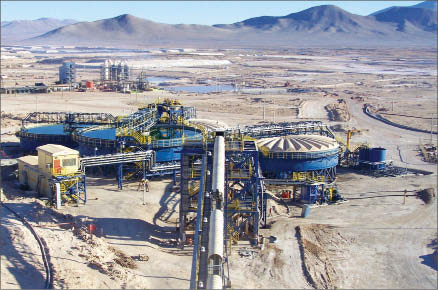The former Red Back Mining team led by Richard Clark has returned to advance Atacama Minerals (AAM-V), using the same strategies they used to build Red Back from a junior with a $50-million market cap into a West African gold producer snapped up by Kinross Gold (k-t, kgc-n) for US$7.1 billion last September.
Clark says in an interview from Chile that, after the Kinross deal, the former Red Back execs shopped around for the right vehicle that would allow them to acquire new properties. They flipped through the Lundin Group’s catalogue of companies and found Atacama Minerals.
“And soon as we looked at it, we went, ‘it’s perfect,’ ” recalls Clark, who in years past had been Atacama’s president and CEO when the company was building the Aguas Blancas iodine-sulphate-nitrate mine in northern Chile.
Atacama’s prized asset started producing iodine in April 2001 and is undergoing a phased development plan to enhance iodine and nitrate production.
Once Aguas Blancas is in its next full phase of production, Clark expects it to generate a free cash flow of around $40 million to $50 million a year. “And if you apply your normal multiple of four- or five-times free cash, this asset should be worth somewhere in the order of one hundred seventy-five million dollars to two hundred million dollars,” he estimates, noting it gives a solid asset base valuation upon which to build a company.
Joining Clark on Atacama’s senior management is Simon Jackson as president, Alessandro Bitelli as chief financial officer, Kevin Ross as chief operating officer and Hugh Stuart as vice-president of exploration.
Tim Miller resigned as Atacama’s president and CEO, and Wanda Lee will retire from her chief financial officer position on Nov. 30.
Atacama’s new executives intend to use Aguas Blancas as bread and butter while examining gold prospects.
“We are not intending to be long-term iodine producers or industrial mineral producers,” Clark says. “What we are looking to do is maximize the value of this asset over the next twelve to eighteen months and use it as collateral to leverage into the gold business.”
Clark says he will use the same strategy he implemented at Red Back to add high-potential properties to Atacama’s portfolio.
He envisions Atacama negotiating agreements with companies that have a mine ready to go but lack the capacity to get it online. He sees his team stepping in with its technical and financial abilities to help build mines.
“That’s how we built Red Back. It’s exactly the same business plan as Red Back. We went in and acquired properties or projects that were at prefeasibility or feasibility level, and we built them,” Clark explains. “That’s how we built Chirano in Ghana and Tasiast in Mauritania.”
After building the mines, the company used the cash flow from the projects to conduct additional exploration. Soon Red Back’s largest shareholder – Kinross, which had eyed the expansion potential at the Tasiast gold deposit – took over.
“We are very fortunate that Rick and his team have joined Atacama,” Lukas Lundin, Atacama’s chairman, said in the press release. “Their significant experience and proven track record will ensure that the Aguas Blancas mine attains the world-class status it deserves.”
The mine has National Instrument 43-101 compliant reserves of 52.2 million tonnes grading 456 parts per million of iodine, 13.2% sulphate and 2.02% nitrate.
Before this year is out, Clark plans to replace Atacama’s operating management team and have Aguas Blancas produce 1,100 tonnes to 1,200 tonnes of iodine for the year. He also aims to get the mechanical leaching plant fully operational to maximize heap leaching.
Along with the fresh faces in management, Atacama plans to buy Sirocco Gold, a private company created by Red Back’s former executives to explore gold prospects and acquisitions targets in West Africa.
Six months ago the plan was to complete a private equity in Sirocco, Clark says. But with the downward trend in the debt, equity and commodities markets, he decided it would make more sense to buy out Sirocco for 20 million Atacama shares.
Sirocco has a joint venture with Kinross in Côte d’Ivoire, which includes three projects and three applications pending. The other exploration program is in Mauritania, where Sirocco has a joint venture with the government’s SNIM mining company, and is earning into three of SNIM’s projects.
The Sirocco takeover is conditional on Atacama completing a $5-million non-brokered private placement consisting of 10 million shares at 50¢. The proceeds will help advance Sirocco’s projects and further explore opportunities in West Africa and South America.
Since Atacama’s new management and Zebra Holdings and Investments – a company controlled by a Lundin family trust – both hold Sirocco shares, the acquisition will be considered a “related-party transaction.”
The junior also has the Salvador potash project on the northeastern coast of Brazil. Located 45 km from the port city of Salvador in Bahia state, the project’s exploration permits cover 2,500 sq. km of the Reconcavo sedimentary basin. Clark says the company is looking for a joint-venture partner for Salvador.
The new management holds 15% of Atacama’s 166.4 million shares outstanding.
On news of the Red Back team taking Atacama’s reins, shareholders pushed the company’s shares up 58% to close Oct. 24 at 87¢.
At presstime its shares traded at 90¢ within a 52-week range of 40¢-$1.02.


Be the first to comment on "The Red Back team returns at Atacama"